Abstract
The results reported here indicate that the short-chain carboxylic acids acetate and propionate stimulate cytoplasmic calcium mobilization in human polymorphonuclear leukocytes, while butyrate and lactate do not. Together with the results of previous work, this indicates that there are at least three classes of short-chain carboxylic acids: those which can alter only cytoplasmic pH (e.g., lactic acid), those which can alter cytoplasmic pH and actin (e.g., butyric acid), and those which can alter cytoplasmic pH, actin, and calcium (e.g., acetate and propionate).
Full text
PDF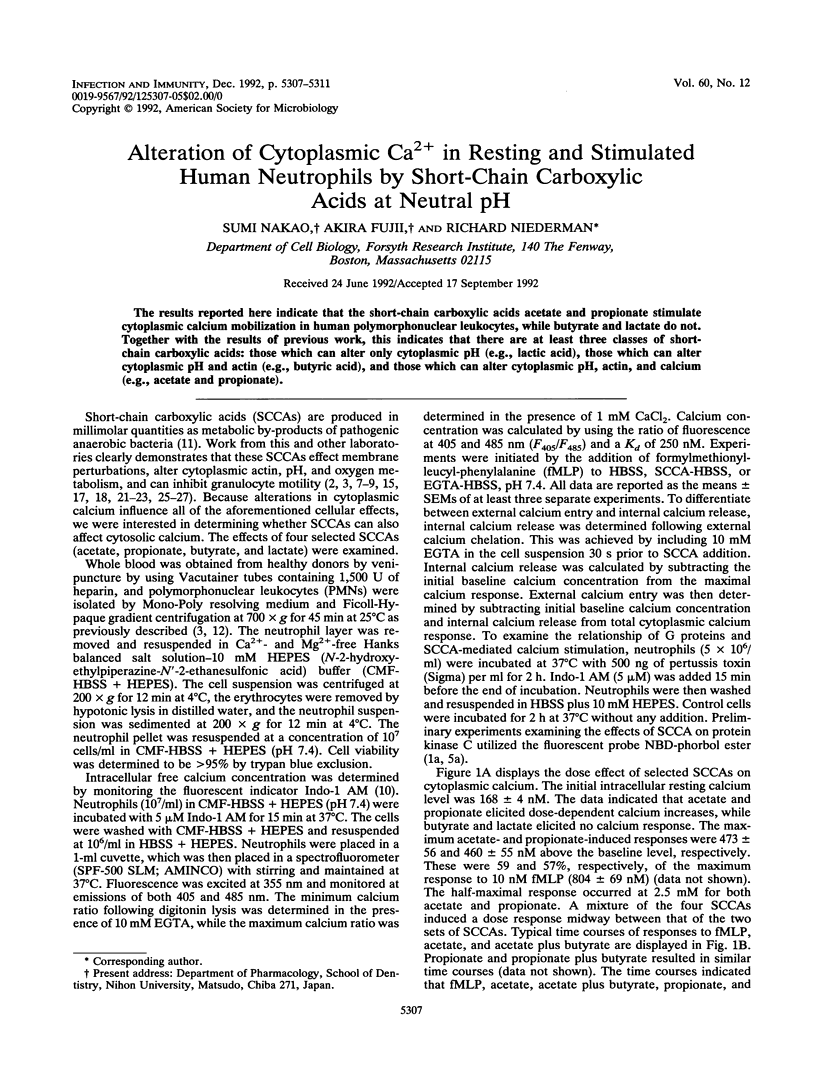
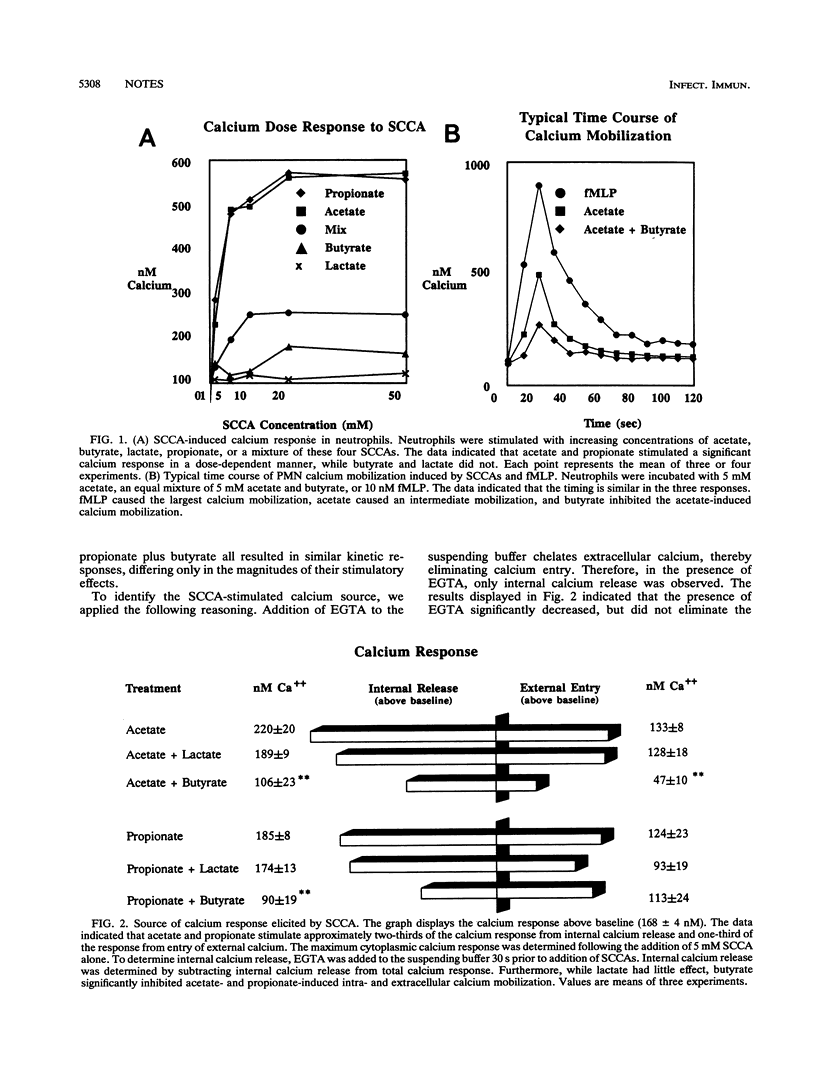
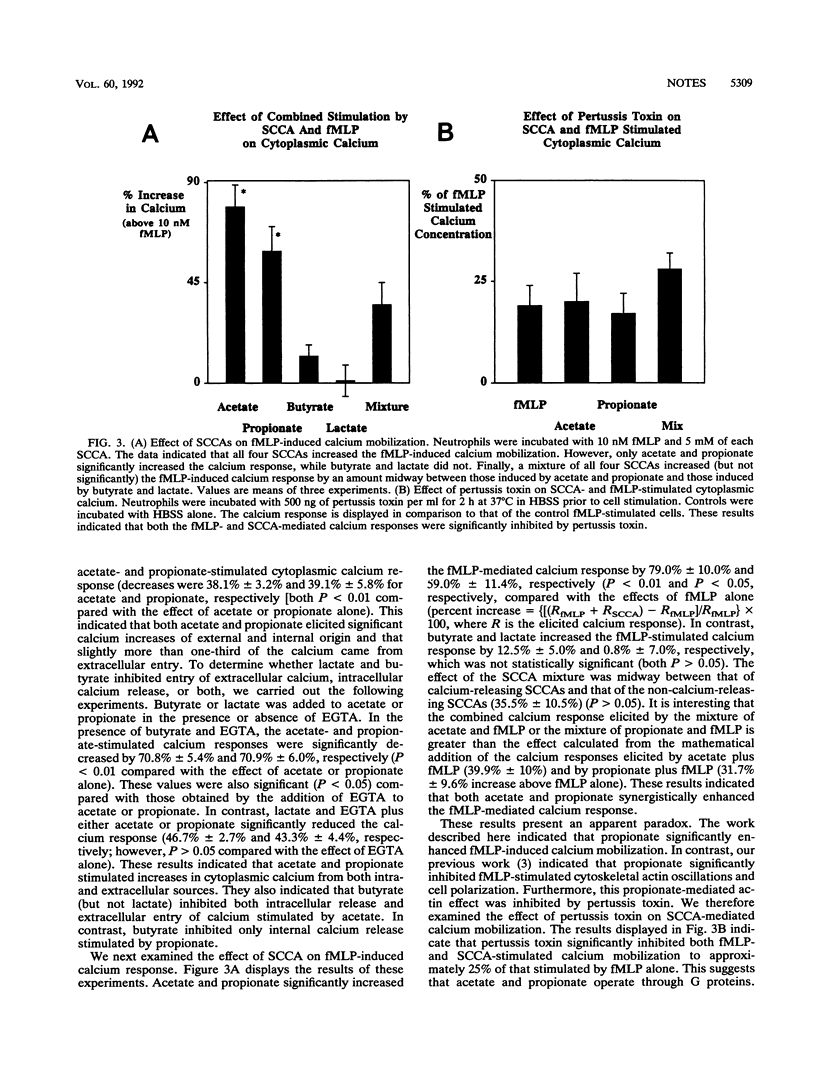
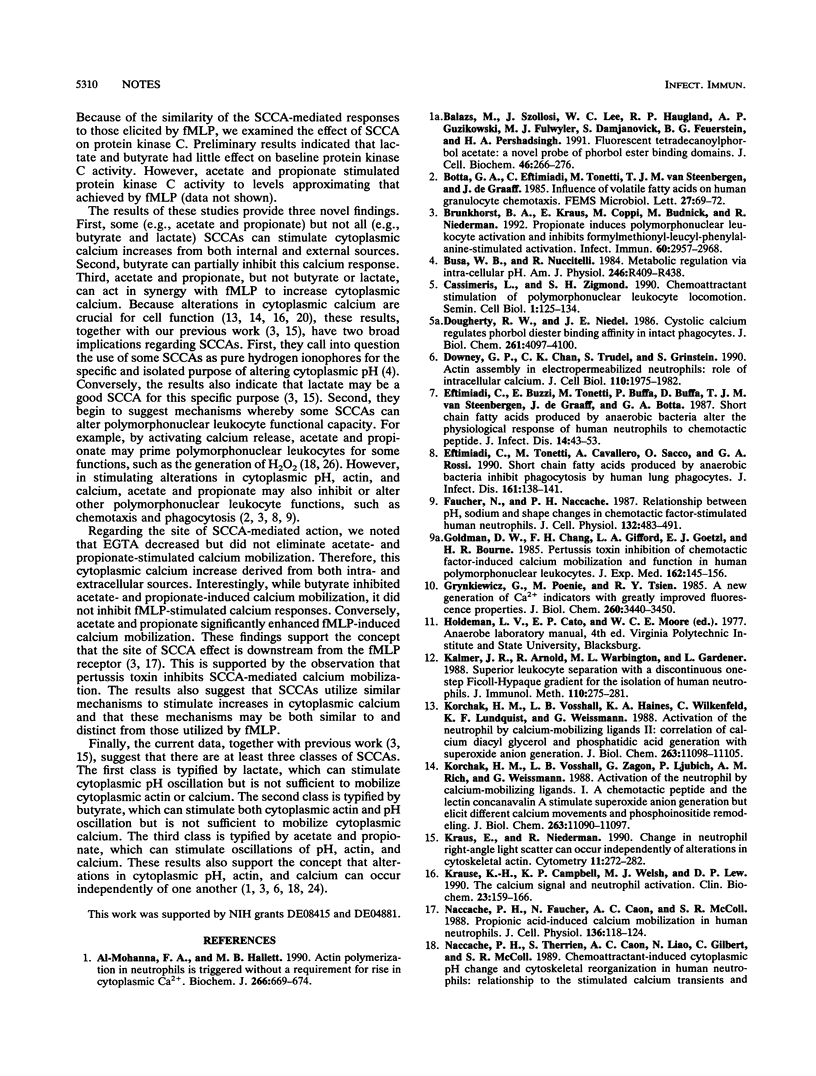
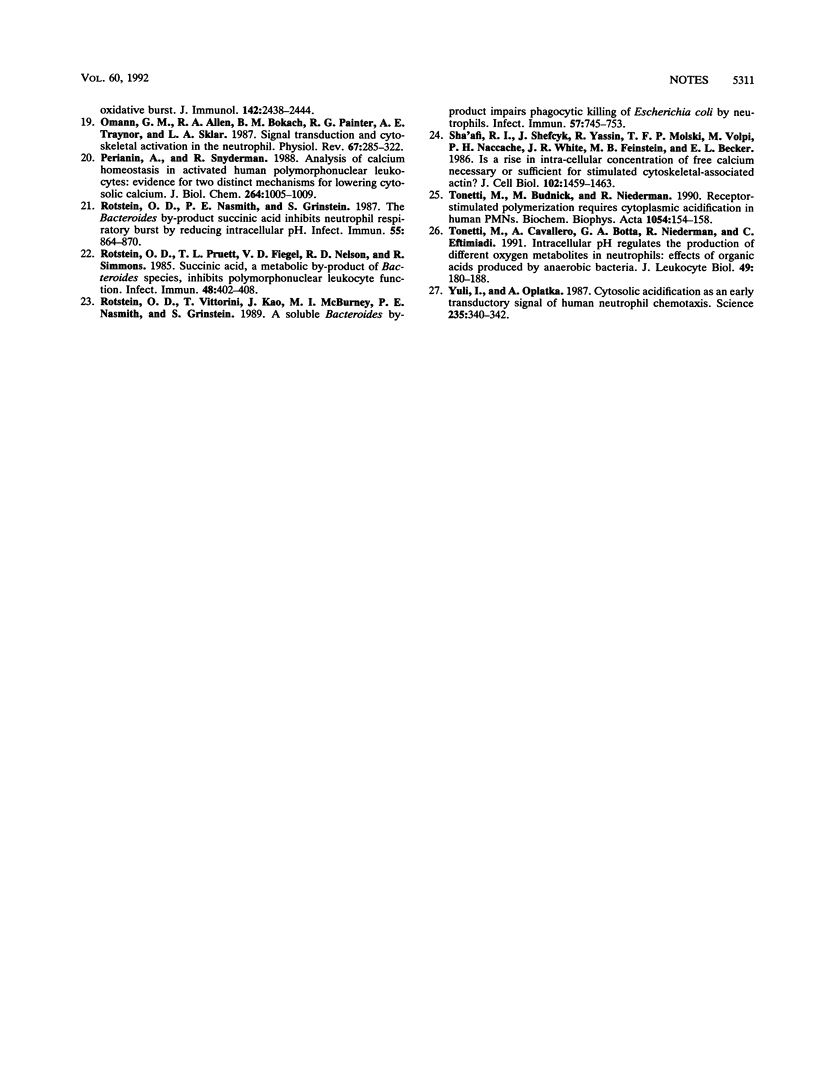
Selected References
These references are in PubMed. This may not be the complete list of references from this article.
- Balázs M., Szöllösi J., Lee W. C., Haugland R. P., Guzikowski A. P., Fulwyler M. J., Damjanovich S., Feuerstein B. G., Pershadsingh H. A. Fluorescent tetradecanoylphorbol acetate: a novel probe of phorbol ester binding domains. J Cell Biochem. 1991 Jul;46(3):266–276. doi: 10.1002/jcb.240460311. [DOI] [PubMed] [Google Scholar]
- Brunkhorst B. A., Kraus E., Coppi M., Budnick M., Niederman R. Propionate induces polymorphonuclear leukocyte activation and inhibits formylmethionyl-leucyl-phenylalanine-stimulated activation. Infect Immun. 1992 Jul;60(7):2957–2968. doi: 10.1128/iai.60.7.2957-2968.1992. [DOI] [PMC free article] [PubMed] [Google Scholar]
- Busa W. B., Nuccitelli R. Metabolic regulation via intracellular pH. Am J Physiol. 1984 Apr;246(4 Pt 2):R409–R438. doi: 10.1152/ajpregu.1984.246.4.R409. [DOI] [PubMed] [Google Scholar]
- Cassimeris L., Zigmond S. H. Chemoattractant stimulation of polymorphonuclear leucocyte locomotion. Semin Cell Biol. 1990 Apr;1(2):125–134. [PubMed] [Google Scholar]
- Dougherty R. W., Niedel J. E. Cytosolic calcium regulates phorbol diester binding affinity in intact phagocytes. J Biol Chem. 1986 Mar 25;261(9):4097–4100. [PubMed] [Google Scholar]
- Downey G. P., Chan C. K., Trudel S., Grinstein S. Actin assembly in electropermeabilized neutrophils: role of intracellular calcium. J Cell Biol. 1990 Jun;110(6):1975–1982. doi: 10.1083/jcb.110.6.1975. [DOI] [PMC free article] [PubMed] [Google Scholar]
- Eftimiadi C., Buzzi E., Tonetti M., Buffa P., Buffa D., van Steenbergen M. T., de Graaff J., Botta G. A. Short-chain fatty acids produced by anaerobic bacteria alter the physiological responses of human neutrophils to chemotactic peptide. J Infect. 1987 Jan;14(1):43–53. doi: 10.1016/s0163-4453(87)90808-5. [DOI] [PubMed] [Google Scholar]
- Eftimiadi C., Tonetti M., Cavallero A., Sacco O., Rossi G. A. Short-chain fatty acids produced by anaerobic bacteria inhibit phagocytosis by human lung phagocytes. J Infect Dis. 1990 Jan;161(1):138–142. doi: 10.1093/infdis/161.1.138. [DOI] [PubMed] [Google Scholar]
- Faucher N., Naccache P. H. Relationship between pH, sodium, and shape changes in chemotactic-factor-stimulated human neutrophils. J Cell Physiol. 1987 Sep;132(3):483–491. doi: 10.1002/jcp.1041320310. [DOI] [PubMed] [Google Scholar]
- Goldman D. W., Chang F. H., Gifford L. A., Goetzl E. J., Bourne H. R. Pertussis toxin inhibition of chemotactic factor-induced calcium mobilization and function in human polymorphonuclear leukocytes. J Exp Med. 1985 Jul 1;162(1):145–156. doi: 10.1084/jem.162.1.145. [DOI] [PMC free article] [PubMed] [Google Scholar]
- Grynkiewicz G., Poenie M., Tsien R. Y. A new generation of Ca2+ indicators with greatly improved fluorescence properties. J Biol Chem. 1985 Mar 25;260(6):3440–3450. [PubMed] [Google Scholar]
- Kalmar J. R., Arnold R. R., Warbington M. L., Gardner M. K. Superior leukocyte separation with a discontinuous one-step Ficoll-Hypaque gradient for the isolation of human neutrophils. J Immunol Methods. 1988 Jun 13;110(2):275–281. doi: 10.1016/0022-1759(88)90115-9. [DOI] [PubMed] [Google Scholar]
- Korchak H. M., Vosshall L. B., Haines K. A., Wilkenfeld C., Lundquist K. F., Weissmann G. Activation of the human neutrophil by calcium-mobilizing ligands. II. Correlation of calcium, diacyl glycerol, and phosphatidic acid generation with superoxide anion generation. J Biol Chem. 1988 Aug 15;263(23):11098–11105. [PubMed] [Google Scholar]
- Korchak H. M., Vosshall L. B., Zagon G., Ljubich P., Rich A. M., Weissmann G. Activation of the neutrophil by calcium-mobilizing ligands. I. A chemotactic peptide and the lectin concanavalin A stimulate superoxide anion generation but elicit different calcium movements and phosphoinositide remodeling. J Biol Chem. 1988 Aug 15;263(23):11090–11097. [PubMed] [Google Scholar]
- Kraus E., Niederman R. Changes in neutrophil right-angle light scatter can occur independently of alterations in cytoskeletal actin. Cytometry. 1990;11(2):272–282. doi: 10.1002/cyto.990110208. [DOI] [PubMed] [Google Scholar]
- Krause K. H., Campbell K. P., Welsh M. J., Lew D. P. The calcium signal and neutrophil activation. Clin Biochem. 1990 Apr;23(2):159–166. doi: 10.1016/0009-9120(90)80030-m. [DOI] [PubMed] [Google Scholar]
- Naccache P. H., Faucher N., Caon A. C., McColl S. R. Propionic acid-induced calcium mobilization in human neutrophils. J Cell Physiol. 1988 Jul;136(1):118–124. doi: 10.1002/jcp.1041360115. [DOI] [PubMed] [Google Scholar]
- Omann G. M., Allen R. A., Bokoch G. M., Painter R. G., Traynor A. E., Sklar L. A. Signal transduction and cytoskeletal activation in the neutrophil. Physiol Rev. 1987 Jan;67(1):285–322. doi: 10.1152/physrev.1987.67.1.285. [DOI] [PubMed] [Google Scholar]
- Rotstein O. D., Nasmith P. E., Grinstein S. The Bacteroides by-product succinic acid inhibits neutrophil respiratory burst by reducing intracellular pH. Infect Immun. 1987 Apr;55(4):864–870. doi: 10.1128/iai.55.4.864-870.1987. [DOI] [PMC free article] [PubMed] [Google Scholar]
- Rotstein O. D., Pruett T. L., Fiegel V. D., Nelson R. D., Simmons R. L. Succinic acid, a metabolic by-product of Bacteroides species, inhibits polymorphonuclear leukocyte function. Infect Immun. 1985 May;48(2):402–408. doi: 10.1128/iai.48.2.402-408.1985. [DOI] [PMC free article] [PubMed] [Google Scholar]
- Rotstein O. D., Vittorini T., Kao J., McBurney M. I., Nasmith P. E., Grinstein S. A soluble Bacteroides by-product impairs phagocytic killing of Escherichia coli by neutrophils. Infect Immun. 1989 Mar;57(3):745–753. doi: 10.1128/iai.57.3.745-753.1989. [DOI] [PMC free article] [PubMed] [Google Scholar]
- Sha'afi R. I., Shefcyk J., Yassin R., Molski T. F., Volpi M., Naccache P. H., White J. R., Feinstein M. B., Becker E. L. Is a rise in intracellular concentration of free calcium necessary or sufficient for stimulated cytoskeletal-associated actin? J Cell Biol. 1986 Apr;102(4):1459–1463. doi: 10.1083/jcb.102.4.1459. [DOI] [PMC free article] [PubMed] [Google Scholar]
- Tonetti M., Budnick M., Niederman R. Receptor-stimulated actin polymerization requires cytoplasmic acidification in human PMNs. Biochim Biophys Acta. 1990 Sep 1;1054(2):154–158. doi: 10.1016/0167-4889(90)90236-7. [DOI] [PubMed] [Google Scholar]
- Tonetti M., Cavallero A., Botta G. A., Niederman R., Eftimiadi C. Intracellular pH regulates the production of different oxygen metabolites in neutrophils: effects of organic acids produced by anaerobic bacteria. J Leukoc Biol. 1991 Feb;49(2):180–188. doi: 10.1002/jlb.49.2.180. [DOI] [PubMed] [Google Scholar]
- Yuli I., Oplatka A. Cytosolic acidification as an early transductory signal of human neutrophil chemotaxis. Science. 1987 Jan 16;235(4786):340–342. doi: 10.1126/science.3798116. [DOI] [PubMed] [Google Scholar]
- al-Mohanna F. A., Hallett M. B. Actin polymerization in neutrophils is triggered without a requirement for a rise in cytoplasmic Ca2+. Biochem J. 1990 Mar 15;266(3):669–674. doi: 10.1042/bj2660669. [DOI] [PMC free article] [PubMed] [Google Scholar]


